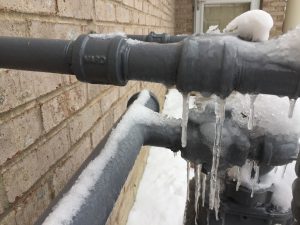The article underneath on the subject of Helpful Tips to Prevent Frozen Pipes this Winter is extremely enjoyable. Read it for your own benefit and see what you think of it.
:strip_icc()/snow-outdoor-faucet-pipes-4af65d1e5e904fb1aa7bf74071fe5d89.jpg)
Winter can ruin your pipes, specifically by freezing pipes. Here's how to prevent it from happening and what to do if it does.
Introduction
As temperature levels decline, the danger of frozen pipes increases, possibly bring about expensive repair work and water damage. Recognizing exactly how to prevent icy pipes is crucial for home owners in cold environments.
Understanding Frozen Pipes
What creates pipelines to ice up?
Pipes freeze when revealed to temperature levels listed below 32 ° F (0 ° C) for expanded periods. As water inside the pipelines ices up, it broadens, taxing the pipeline walls and potentially creating them to break.
Risks and damages
Icy pipelines can lead to water system disturbances, building damage, and costly repair work. Ruptured pipelines can flooding homes and trigger substantial architectural damages.
Indications of Frozen Water Lines
Determining frozen pipes early can avoid them from rupturing.
Just how to identify frozen pipelines
Look for decreased water flow from taps, unusual odors or sounds from pipelines, and visible frost on exposed pipes.
Avoidance Tips
Shielding prone pipes
Cover pipelines in insulation sleeves or utilize warmth tape to secure them from freezing temperatures. Concentrate on pipelines in unheated or exterior locations of the home.
Heating methods
Keep indoor areas properly warmed, especially areas with plumbing. Open up cupboard doors to permit warm air to flow around pipelines under sinks.
Securing Exterior Plumbing
Garden pipes and exterior faucets
Disconnect and drain yard tubes prior to winter. Install frost-proof faucets or cover outdoor taps with insulated caps.
What to Do If Your Pipes Freeze
Immediate activities to take
If you suspect frozen pipes, maintain taps open up to relieve pressure as the ice melts. Use a hairdryer or towels soaked in hot water to thaw pipes gradually.
Long-Term Solutions
Architectural modifications
Think about rerouting pipes far from exterior wall surfaces or unheated locations. Add added insulation to attic rooms, basements, and crawl spaces.
Updating insulation
Invest in high-quality insulation for pipelines, attics, and wall surfaces. Proper insulation assists maintain regular temperature levels and lowers the risk of frozen pipes.
Verdict
Stopping frozen pipes calls for proactive procedures and fast responses. By comprehending the reasons, indicators, and preventive measures, house owners can secure their pipes during cold weather.
6 Proven Ways to Prevent Frozen Pipes and Protect Your Home
Disconnect and Drain Garden Hoses
Before winter arrives, start by disconnecting your garden hoses and draining any remaining water. Close the shut-off valves that supply outdoor hose bibs and leave the outdoor faucet open to allow any residual water to drain. For extra protection, consider using faucet covers throughout the colder months. It’s also important to drain water from any sprinkler supply lines following the manufacturer’s directions.
Insulate Exposed Pipes
Insulating your pipes is an effective way to prevent freezing. Pipe insulation is readily available at home improvement stores and is relatively inexpensive. Pay close attention to pipes in unheated areas such as the attic, basement, crawl spaces, or garage. Apply foam insulation generously to create a buffer against the cold. You can also wrap your pipes in heat tape or thermostat-controlled heat cables for added warmth.
Seal Air Leaks
Inspect your home for any cracks or openings that could let in cold air. Seal any holes around the piping in interior or exterior walls, as well as the sill plates where your home rests on its foundation. Additionally, make sure to keep your garage door closed unless you’re entering or exiting. Leaving it open creates a significant air leak that can lead to frozen pipes.
Allow Warm Air Circulation
During cold snaps, it’s essential to allow warm air to circulate evenly throughout your home. Leave interior doors ajar to promote better airflow. Open kitchen and bathroom cabinets to help distribute heat consistently around the rooms. If you have small children or pets, be sure to remove any household chemicals or potentially harmful cleaners from open cabinets for safety.
Let Faucets Drip
A small trickle of water can make a big difference in preventing ice formation inside your pipes. When temperatures drop significantly, start a drip of water from all faucets served by exposed pipes. This continuous flow helps prevent the water from freezing. Additionally, running a few faucets slightly can relieve pressure inside the pipes, reducing the chances of a rupture if the water inside does freeze.
https://choateshvac.com/6-proven-ways-to-prevent-frozen-pipes-and-protect-your-home/

Hopefully you enjoyed our topic about Helpful Tips to Prevent Frozen Pipes this Winter. Many thanks for taking the time to read through our blog post. Sharing is good. You just don't know, you may very well be helping someone out. I praise you for your time. Please check our website back soon.
Call Today
Comments on “Important Tips for Avoiding Frozen Pipes in Winter Conditions”